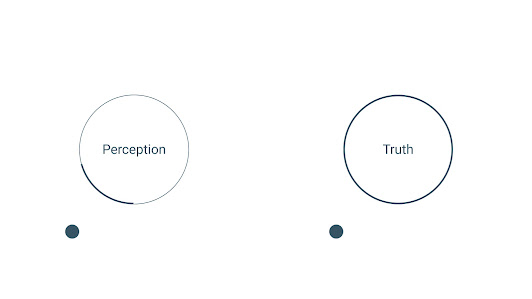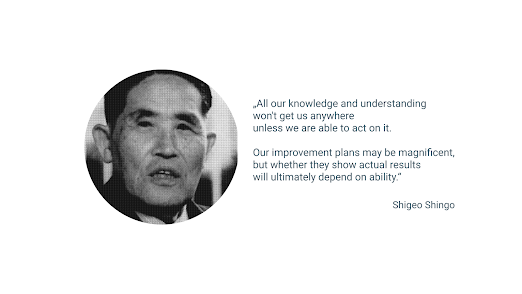L5: Learning to See
It is not what you look at that matters,
it is what you see
- Henry David Thoreau
Just a blink of a second, and you can make the right decision. Or not. It depends - it depends on many factors. One factor is experience. Not knowledge but skill.
We do not acquire skills by reading. We develop a skill by doing – that is where learning is coming from. We can experience that in math. To learn how to calculate the equation, we need to calculate them. There is no other way. My math teacher at high school taught me one method to solve any equation. That method is called: I look, and I see.
The teacher told me: to be good at math, you need to do homework, you need to calculate many equations, many different equations. Then, after the time, you will get to the point where just by seeing the equation, you will immediately know how to solve it.
That is the reason why math teachers are good at solving equations. They solved thousand of different equations. They spend a lot of time practicing math. What they see when looking at an equation is how to solve it. What we see is an equation. It is an easy method but definitely not one we can learn quickly.
If the "I look, and I see" method can be applied in math, can it be used in other fields?
Let's try to apply this method on the shop floor in production. Based on the method, all we need is practice. Not knowledge, practice. Well, we might say it is easier with math because the formulas are always the same as how to solve them. Whereas production is always different, full of risk and uncertainty.
In fact, it is easier with math. When we forget the formula, we experiment with numbers and algebra and derive the formulas on our own again. Math is easy because there's nothing illogical about it. Math is easy because we can check our answers by redoing the problem differently yet consistently arrive at the same solution.
On the other hand, however, production might look messy; we always have a reference point: LEAN. Following the LEAN approach, we find that there is nothing illogical in production. We will also find out that we arrive at the solution by consistently experimenting. How do we then acquire the practice in LEAN?
We acquire practice in LEAN by being on the shop floor - where the magic happens – some clever minds also call it: being on Gemba.
Being on Gemba, I found myself in three situations:
1. Lost in space – having no clue what was happening.
2. Having Answers – criticizing conditions.
3. Having Questions – aiming to understand.
Lost in space
Honestly, I had no clue what was happening when observing a particular process in the early beginnings. There was too much happening to digest at once. I wondered how people could orient themselves there; it was a complete mess – at least it seemed to me like that.
In the book Zero Quality Control, Shigeo Shingo points out that we need to consider five production elements to engage ourselves in production. Even though this clustering of production mechanism is meant to challenge the status quo and look for improvement. I realized they are also helpful in understanding production activities themselves. That was the first step out of being lost. Till that moment, I knew LEAN tools and practices, but I was missing the content, and I did not know what I was missing 😊
Having answers
Being a LEAN lecturer gave me a false feeling I know everything about LEAN. Mainly because I narrowed LEAN to the tools such as 5S, eight wastes, or VSM. It was so easy to point out a lousy workplace setup – because it simply did not match 5S standards. It was easy to criticize the amount of inventory because inventory is waste – as described in 8 wastes of production. It was easy to attack the way supervisors solved the problem because they did not follow A3 or PDCA. It was easy but not correct.
"To criticize" might not be the correct verb. I never wanted my opinion to sound like criticism. But let's be honest. As a consultant and lecturer, I needed answers and ideas to point out the wrong. What a false assumption!
"Masters talking to each other do not criticize anyone.
They enrich themselves with knowledge through communication.
They exchange the experience that helps them in their lives - their lessons and solutions to tasks.
What's the point of criticism. Everything is proven in combat.
I will ask one question to critics. Show me what you can do.
You should speak only if you have personal experience. Not knowledge but skill."
- Russian bishop response to criticisms.
Spending more time on the shop floor, I realized that the production system is about trade-offs. The trade-off between utilization and throughput. The trade-off between the lead time and inventory cost. And many others, you name them.
There is never only one clear answer. There is a discovery and experimentation to find the proper solution.
And there are many solutions on the shop floor. Many excellent solutions are based on necessary trade-offs. So before giving the opinion, I need to understand what is really happening.
When there is a problem in production, the correct answer to the problem is I don't know yet. Even better answer is: Let's find out the answer together 😉
Having questions
If you looked for everything in a room that was red and then you had to close your eyes and describe everything that was blue, what would happen?

We have our own way of understanding and interpreting. This is influenced by our experience and the different biases we carry with us.
Henry David Thoreau wants us to understand that it is often the "unseen" or the "perceived" that is far more important than the "seen." It is not what you look at that matters; it is what you see. Focusing on red things, we will see red things, and if we don't find them, we might criticize not enough red stuff. The opposite of looking for red things is being curious. Being curious what other colors there might be in the environment we are observing.
Being curious means having questions. Questions to understand the situation. Questions to understand the trade-offs. Questions to understand the gap between the production system in place and LEAN.
"I look, and I see" on the shop floor might not be so straightforward as in math, where practice is the key. "I look, and I see" on the shop floor is a combination of LEAN understanding and curiosity to understand the ongoing situation.
The first step to Learning to See is to master LEAN thinking. The second step is to believe in people's good intentions in developing production systems. The third step is to learn how to ask the right questions.
Learning to see does not have an end.
Learning to see is ongoing observation.
Learning to see is ongoing experimentation.
Learning to see are enriching conversations.
Cheers,
Marek


Hey Marek, great article, I am a fan of metaphors and comparisons. So, I like that you have chosen Maths.
ReplyDeleteWhile reading there was one thought coming into my mind (indeed, no criticism 😀):
I agree, with the right amount of practice it is getting easier to solve any equation in math. However, that is only valid as long as you have as many answers (=equations) as questions (=variables). If the number of variables exceeds the number of equations, you must use assumptions.
And eventually, the quality of your assumptions determines the quality of your answers/decisions/actions.
Now the question is: What influences the quality of your assumptions when it comes to LEAN? Or even any other topic?
Best regards
Björn
Synthesis - that's the firsthand answer.
DeleteIn Lean we work with assumptions a lot.
I always create an assumption based on what I see and based on synthesis.
E.g. I see a FIFO of storage before an assembly line. Then I ask: how does this “buffer” fit a production system?
Then the assumption is that: Assembly line produces in one-piece flow at lot size one. As in FIFO, I see that each storage is different.
So the quality of assumptions is equal to our ability to synthesize on the shop floor.